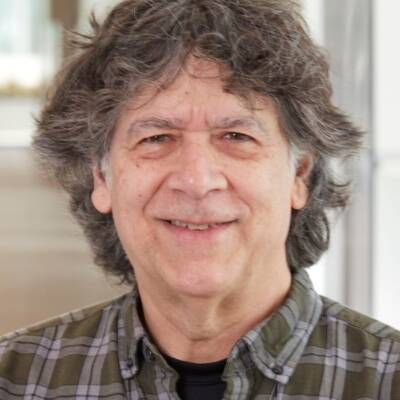When I started as a post-doc in the laboratory of Gunter Blobel in 1984, he had resolved many of the key questions about how proteins are targeted to membranes, for which he received the Nobel Prize in 1999. The key remaining question, which became the focus of my studies, was how do macromolecules fully move across membranes to be secreted or partially across to be integrated into the membrane. My first key demonstration was that there was an aqueous channel for the movement of proteins across membranes (Simon & Blobel 1991) and that the signal sequence was sufficient to open these channels (Simon & Blobel, 1992). Next I showed that integral membrane proteins move across the membrane and assembly in an aqueous channel (Borel & Simon 1996a,b). Subsequently I showed an aqueous channel is also used by the Type III secretion system for the movement of larger macromolecules such as filamentous phage across membranes (Marciano et al 1999).
- Simon,SM, Blobel,G A protein-conducting channel in the endoplasmic reticulum. Cell 1991 65:371-380.
- Simon, SM, Blobel, G Signal peptides open protein-conducting channels in E. coli. Cell. 1992 May 15;69(4):677-84.
- Borel, AC, Simon, SM. Biogenesis of polytopic membrane proteins: membrane segments assemble within translocation channels prior to membrane integration. Cell 1996 85 (3):379-89.
- Marciano, DK, Russel, M, Simon, SM. An Aqueous Channel for Filamentous Phage Export. Science 1999 284:1516-9.
My studies with Gunter Blobel demonstrated that proteins moved across membranes through aqueous channels, but that begged the question of the mechanism that moved the proteins. I proposed a biophysical mechanism which linked the chemical potential energy of translation to the movement of proteins. The term I coined in the first paper (Simon et al. 1992) was a “Brownian Ratchet”, and the fundamental idea and the term has since been applied to many other molecular motors. Recently I have been using biophysical mechanisms to analyze the structure and function of the nuclear pore (Kampman et al. 2011), and we have used the results to further develop the theory and testing of the Brownian Ratchet hypothesis (Mincer and Simon, 2011.
- Simon, SM, Peskin, CS, Oster, GF. What Drives the Translocation of Proteins? Proc.Natl.Acad.Sci.U.S.A. 89 (9):3770-4, 1992. PMCID: PMC525572.
- Kampmann, M, Atkinson, CE, Mattheyses,AL, Simon, SM. Mapping orientation of nuclear pore proteins in living cells with polarized fluorescence microscopy. Nature Struct Mol Biol. 18 (6):643-649, 2011. PMCID: PMC3109191.
- Mincer, JS, Simon, SM. Simulations of nuclear pore transport yield mechanistic insights and quantitative predictions. Proc.Natl.Acad.Sci.U.S.A 2011 Aug 2; 108 (31):E351-8.PMCID: PMC3150947.
- Pulupa J, Rachh M, Tomasini MD, Mincer JS, Simon SM. A coarse-grained computational model of the nuclear pore complex predicts Phe-Gly nucleoporin dynamics(opens in new window). J Gen Physiol. 2017 Oct 2;149(10):951-966. doi: 10.1085/jgp.201711769. Epub 2017 Sep 8. PubMed PMID: 28887410; PubMed Central PMCID: PMC5694938.
In the early 1980s there were many models for learning that focused on the role of ion channels in modulating the waveform of the action potential and thus the entry of calcium into the presynaptic terminal. Together with my PhD advisor, Rodolfo Llinas, I was the first to voltage-clamp a presynaptic terminal to the waveform of an action potential and explore the effects of modulating the waveform on release and, in the process quantifying the entry of calcium into the presynaptic terminal during an action potential (Llinas, et al 1982). Many groups had quantified the calcium current into the presynaptic terminal and found that it was difficult to relate to transmitter release. I proposed to examine the local changes of calcium entry into the cell using numerical modeling (Simon & Llinas, 1985). While this first introduction of the idea of localized calcium changes initially caught many by surprise, the concept is now almost universally accepted. Subsequently, we helped pioneer the very first application of total internal reflection fluorescent microscopy to imaging vesicle fusion (Schmoranzer et al. 2000), the first reconstitution of vesicle fusion where one could image single vesicles (Fix et al. 2004) as well as many cell biological studies of endo- and exocytosis (Jaiswal et al. 2009).
- Fix, M, Melia, TJ, Jaiswal, JK, Rappoport, JZ, You, D, Söllner, TH, Rothman, JE, Simon, SM. Imaging single membrane fusion events mediated by SNARE proteins. Proc.Natl.Acad.Sci.U.S.A 2004 101 (19):7311-6, . PMCID: PMC409915.
- Jaiswal, JK, Rivera, VM, Simon, SM. Exocytosis of post-Golgi vesicles is regulated by components of the endocytic machinery. Cell 2009 137 (7):1308-19. PMCID: PMC3237386.
- linás R, Sugimori M, Simon SM. Transmission by presynaptic spike-like depolarization in the squid giant synapse. PNAS (USA). 1982; 79(7):2415-9. PMCID: PMC346205.
- Simon, SM, Llinás, RR. Compartmentalization of the submembrane calcium activity during calcium influx and its significance in transmitter release. Biophys.J.1985 48:485-98.


